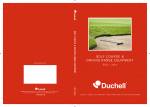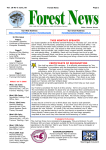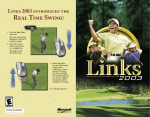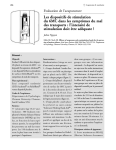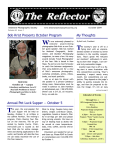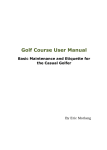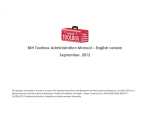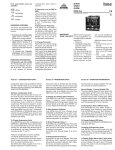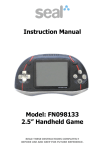Download 2015 MWLGC Players Manual
Transcript
This booklet has been prepared to assist you in better understanding the game of golf and to explain Mill Woods Ladies Golf Club (MWLGC) activities and special events. You will find additional 2015 Mill Woods Ladies League Players Manual information and sign-up sheets posted on our bulletin board in the room behind the restaurant (referred to as clubroom in this document). If you have any questions, feel free to ask any member of the executive, other experienced members, or the pro shop staff. Mill Woods Golf Course phone number 780 448 1601 Mill Woods Golf Course website www.millwoodsgolfcourse.com The purpose of the Mill Woods Ladies Golf Club is: The primary purpose of this golf club is to provide for the recreation of the members, to promote and afford opportunity for friendly and social activities, and to encourage and promote amateur games and exercise. Table of Contents Welcome to Mill Woods Ladies Golf Club (MWLGC)................................................... 4 Executive Team ....................................................................................................................... 5 Booking Tee Times ................................................................................................................ 5 Club Fees ................................................................................................................................... 6 Club Policies ............................................................................................................................. 6 Refunds................................................................................................................................................. 6 Handicap Establishment ................................................................................................................ 6 Eligibility for Club Championship ............................................................................................... 6 Club Activities .......................................................................................................................... 7 Birdie Cage .......................................................................................................................................... 7 Break '100', '90', '80' ....................................................................................................................... 7 Match Play ........................................................................................................................................... 7 Pin Days ................................................................................................................................................ 8 Ringer Board ...................................................................................................................................... 8 Weekly Proximity Prizes ................................................................................................................ 8 Major Tournaments .............................................................................................................. 9 Classic Tournament ......................................................................................................................... 9 Better Ball Tournament ................................................................................................................. 9 Club Championship .......................................................................................................................... 9 Mini Tournaments ................................................................................................................. 9 Interclub Events.................................................................................................................... 10 Marshall Cup .................................................................................................................................... 10 Podersky Cup .................................................................................................................................. 10 Visiting Days .................................................................................................................................... 10 POP (Pace of Play) ................................................................................................................ 11 Glossary ................................................................................................................................... 12 Entering Scores ..................................................................................................................... 13 How to Enter Your Score ............................................................................................................. 13 How to Enter a Hole by Hole Score .......................................................................................... 14 How to Create a Course List ....................................................................................................... 14 Handicaps and Acceptable Scores ........................................................................................... 15 Rules of Golf ..................................................................................................................................... 15 Equitable Stroke Control (ESC) ................................................................................................. 15 Corralling the Sandbagger! ........................................................................................................ 15 Temporary Greens for Handicap Purposes .......................................................................... 16 New Golfers ...................................................................................................................................... 16 Net Disqualification Not Affecting Score ............................................................................... 16 Unacceptable Scores for Handicapping Purposes ............................................................. 16 Match and Stroke Play Rounds ................................................................................................. 16 Easy Guide to the Etiquette & Rules of Golf ................................................................. 17 Etiquette............................................................................................................................................ 17 The Spirit of the Game .......................................................................................................................... 17 Safety.............................................................................................................................................................. 17 2 Consideration of Others ...................................................................................................................... 17 Putting Green ............................................................................................................................................ 17 Pace of Play ................................................................................................................................................. 17 Care of the Course ................................................................................................................................... 18 Definitions ........................................................................................................................................ 18 Rules ................................................................................................................................................... 19 Local Rules .................................................................................................................................................. 19 Rule 1 – The Game .................................................................................................................................. 19 Rule 2 – Match Play ................................................................................................................................ 19 Rule 3 – Stroke Play ............................................................................................................................... 20 Rule 4 – Clubs ............................................................................................................................................ 20 Rule 5 – The Ball ...................................................................................................................................... 20 Rule 6 – The Player................................................................................................................................. 20 Rule 7 – Practice ...................................................................................................................................... 20 Rule 8 – Advice.......................................................................................................................................... 21 Rule 9 – Information as to Strokes Taken ................................................................................. 21 Rule 10 – Order of Play ........................................................................................................................ 21 Rule 11 – Teeing Ground ..................................................................................................................... 21 Rule 12 – Identifying Your Ball ........................................................................................................ 21 Rule 13 – Play the Ball as it Lies ...................................................................................................... 21 Rule 14 – Striking the Ball .................................................................................................................. 22 Rule 15 – Wrong Ball ............................................................................................................................. 22 Rule 16 – Putting Green ....................................................................................................................... 22 Rule 17 – The Flagstick ........................................................................................................................ 22 Rule 18 – Ball at Rest Moved ............................................................................................................. 23 Rule 19 – Ball in Motion Deflected................................................................................................. 23 Rule 20 – Lifting and Dropping ........................................................................................................ 23 Rule 21 – Cleaning the Ball ................................................................................................................ 24 Rule 22 – Ball Assisting or Interfering with Play ................................................................... 24 Rule 23 – Loose Impediments .......................................................................................................... 24 Rule 24 – Obstructions ......................................................................................................................... 24 Rule 25 – Abnormal Ground Conditions..................................................................................... 24 Rule 26 – Water Hazards..................................................................................................................... 25 Rule 27 – Lost Ball and Out of Bounds ......................................................................................... 25 Rule 28 – Ball Unplayable ................................................................................................................... 26 Rules 29 – 34 – For More Info… ....................................................................................................... 26 The Rules of Ready Golf ..................................................................................................... 27 On The Tee ....................................................................................................................................... 27 On The Fairway............................................................................................................................... 27 Helping To Find Lost Balls .......................................................................................................... 28 Entering And Exiting Greens...................................................................................................... 28 Speeding Play On The Greens .................................................................................................... 28 Farthest From The Hole............................................................................................................... 29 Summary ........................................................................................................................................... 29 3 Welcome to Mill Woods Ladies Golf Club (MWLGC) On behalf of the MWLGC executive, I am excited to welcome each of you to the Mill Woods Ladies Golf Club for 2015. It is my pleasure to serve you and I look forward to meeting and golfing with our new members and enjoying a round with the familiar faces of seasons past. We know you will enjoy the Mill Woods Golf Course, networking with fellow members and renewing old friendships as well as finding new “golf buddies”. Our club is unique in that we are comprised of both day and business ladies. We are one club and operate as such. All the weekend tournaments give us the opportunity to come together and play with women we might not otherwise have the opportunity to golf with. I remember when I first started with the club and golfed in my first weekend tournament playing with some business ladies. I was terrified – but I soon found they were just as friendly and fun to be with as the ladies I had met as a day lady. I am sure many of our business ladies have had a similar experience. One of the key benefits of a ladies group like ours is the opportunity to meet other women golfers with whom we can play and compete in friendly competitions. I’d like to encourage everyone to attempt to meet and play with someone new this year. We are excited that this year we have once again taken a technological step forward by introducing our very own website. We hope to provide you with all the information you could possibly hope for with this new addition. You can find our website at www.mwlgc.ca. If you have any questions or concerns, the members of your executive team are happy to help out. We appreciate your feedback and suggestions for improvements to our club. You can email your requests, concerns and questions to me or any other MWLGC executive member. Want to meet more golfers and have some fun? Consider joining the executive in the 2016 season. If you are interested, please let us know. We’ll find a spot that fits with your expertise and skill set. And seriously, we do have a lot of fun for a minimal time commitment! Enjoy yourselves and have fun out there! Janice Martin, President Mill Woods Ladies Golf Club One of the most fascinating things about golf is how it reflects the cycle of life. No matter what you shoot - the next day you have to go back to the first tee and begin all over again and make yourself into something. - Peter Jacobsen Return to Table of Contents 4 Executive Team President Janice Martin [email protected] President-Elect Rebecca Fricker [email protected] Secretary Cheryl Doucet Treasurer Leslie McEvoy EGA Rep Bev Boersma Committees Club Captain Jo-Ann Pethybridge [email protected] Assistant Club Captain Elaine Shannon [email protected] Membership Chairs Marilyn Bulat [email protected] Bev Sedgwick [email protected] Prize Chairs Tania Topolnyski Kay Willekes Social Convener Debbie DeLuca Booking Tee Times Go to the Mill Woods Golf Course website. Click on the drop down “Book A Tee Time” then “Book a League”. Click on the words “can’t sign in” and enter the email address that you provided to the Mill Woods Ladies Club. A User Name and Password will be sent to you. You now have the tools you need to book a tee time! 1. One week prior to the Tuesday on which you plan to golf, go to the Mill Woods Golf Course web page and click “Book a Tee Time” and then “Book a League.” (Booking opens at 7:00 a.m.) 2. Use your User Name and Password to enter the booking system. 3. Choose the upcoming Tuesday as the date you wish to play and choose an available time. You may book for yourself and one player with whom you wish to play. 4. You will receive a confirmation email with your date and time. 5. You can cancel or edit your tee time by clicking the button Menu, a drop down appears, click “Edit a Tee Time” and proceed from there. If you can’t get to a device to cancel on-line, you may call the Pro-Shop, but that should be your second choice. The ladies in our league who do not have computers may call the Pro Shop on the Tuesday prior to league play and ask to have a tee time made or they may ask a friend to book a tee time and play together. Our tee times are set on the booking system. In the case a Tuesday is not available, the Tee-On Booking System will prompt you to the alternate day that has been made available. Return to Table of Contents 5 Club Fees MWLGC – 2015 Entry Fee: $110.00 (based on actuals from 2014 season) RCGA & Other Association Fees 36% Prizes 32% Catering 23% Interclub Expenses 5% Trophies 3% Administrative Expenses 1% Club Policies Please note the following MWLGC policies: Refunds If a member withdraws from the club before the spring meeting, they will be issued a full refund. A $20 administration fee will be charged if membership is cancelled after the spring meeting but before May 1st. No refunds issued after May 1st. Handicap Establishment No one may compete in a tournament or other competition until she has established a handicap or has a transfer of a handicap from another accredited course, unless the event has a special section for such members. Eligibility for Club Championship In order to be eligible to play in the club championship proper, a member must have entered in the Golf Canada website five (5) scores that includes 3 – 18 or 6 – 9 hole scores played at the Mill Woods Golf Club during the current season prior to the championship qualifying day. Return to Table of Contents 6 Club Activities Birdie Cage If you make a birdie during MWLGC rounds, place your name on a "Birdie Cage" chit located in the clubroom. A draw will be made at the Annual Banquet and an award presented. Note: Only birdies made during club play rounds and tournaments are eligible. Break '100', '90', '80' Congratulations! Pins are awarded to those players who break 100, 90 and 80 (gross score) for the first time. There is a list posted on the Ladies Bulletin Board in the clubroom. When you achieve one of these milestones record it on the list. Your pin will be awarded at the end of the year Banquet. Note: A pin is awarded for the first time break only. Match Play This is an individual competition for members with an established handicap. Each player is guaranteed 2 rounds. Sign-up sheets are available at the Spring Meeting and are posted thereafter on our bulletin board in the clubroom. Please sign up by mid-May. There is a small fee ($5 for the season) as well as the green fees. Match play begins in early June. A double elimination format is used. The number of rounds played will depend on the number of players who sign up to play. All competitions must be played by the deadline dates stipulated so players may need to be flexible in order to schedule a tee time for the match. Matches are played using current Handicaps. Players must verify their Handicaps before play. Maximum allowed Handicap is 40. Matches consist of 18 continuous holes. The outcome is determined based on the holes won rather than total number of strokes. In the event of a tie after 18 holes, players continue to play on a hole-by-hole, “sudden death” basis. The Match Play Committee will provide more detailed information about the format and rules of play to the players who register for match play. A cash prize will be awarded to the winner and runner-up in both day ladies and business ladies competitions. Return to Table of Contents 7 Pin Days This is a nationally sponsored competition played during league days. We have 10 Tuesdays designated as PIN DAYS. RCGA Rules apply. All strokes must be counted and no “gimme” putts allowed. Keep track of your actual score, and enter your GROSS score and your NET score into the PIN DAY binder. To be eligible for a prize you must have a minimum of 4 Pin Day scores out of the 10 Pin Day events. There are four prize categories: 18 hole Day Ladies and Business Ladies and 9 hole Day Ladies and Business Ladies. Ringer Board The Ringer Board is a hole-by-hole record of your personal game improvements (stroke for stroke) through the season. This is open to all members. Scores from league play (9 or 18 holes) or weekend club tournaments may be used. The competition commences with the first day of league play and concludes on September 22, 2015. On the first day of league play, take a card from the Ringer Board box, put your name on it and then circle the score that you shot for each hole. This is week number one. Record any pars, birdies, eagles and chip-ins at the top of the card and keep a running total of these for the entire season. Each week when you golf, pull your card and circle any scores on each hole that you improved on from previous weeks. After entering your improvements, pars, birdies, eagles and chip-ins, file your card back in the Ringer Board box alphabetically. Prizes will be awarded, by flights, at the year-end banquet. Weekly Proximity Prizes Each week, except for when we have a mini tournament, during regular club play everyone has the opportunity to win a prize by participating in the proximity challenges of the day. There is no cost involved for these prizes. Each week there will be a different competition that will be indicated on the Loonie Pot sheet in the Pro-Shop as well as by a marker on the appropriate hole. These competitions could range from shortest drive, to being in a sand trap or water hazard, to getting onto a Par 5 green in regulation. There is also a Loonie Pot each week. This competition will cost you $1. There is a sign-up list in the Pro Shop that will tell you where and what the competition is for that week. It will mostly be longest drive or longest putt, but you never know, so keep your eyes open. These are just little fun competitions to add a touch of variety to your day – and who knows – maybe you’ll get a free lunch out of it! Return to Table of Contents 8 Major Tournaments Classic Tournament This is the first tournament of the season. There is a fee - $15 – which must be paid in the proshop in order to register. Play is 18 holes using the RCGA rules of golf. Golfers are grouped in flights, according to their established handicaps, so you will be playing with others of a similar skill level. You must have an established handicap to participate. The player with the lowest gross score is named the tournament champion. The player with the lowest net score is the runner-up. Winner’s names are engraved on permanent trophies that the winner has in her possession for a one-year period. Flight prizes and proximity prizes are also awarded. Better Ball Tournament This is a tournament that is played with a partner. There is a fee - $15 – which must be paid in the pro-shop in order to register. Play is 18 holes with each team player playing their own ball. The team scores are determined by using the best net score of the two players on the team. You must have an established handicap to participate. The top teams with the lowest net scores will be awarded prizes. The number of prizes awarded is dependent on the number of participants. Proximity prizes are also awarded. Club Championship Stroke Play is used. Two 18-hole rounds (Saturday & Sunday) are played using the RCGA rules of golf. Golfers are flighted according to handicap, so you will be golfing with others at a similar skill level. You must have an established handicap to participate. The player with the lowest gross score is named the Club Champion. The player with the lowest net score is the runner up. Winner’s names are inscribed on permanent trophies that the winner will have in her possession for a one-year period. Flight and proximity prizes are also awarded. Mini Tournaments We have two mini tournaments each season. The format of the tournament is determined by the Club and Assistant Club Captains. The mini tournaments are followed by a hosted meal in the banquet room. Rules will be provided on the day of the tournament. Prizes are awarded at each Mini Tournament. Ties are broken by a count back where applicable. There will be sign-up sheets for these tournaments posted in the clubroom. Return to Table of Contents 9 Interclub Events Interclub tournaments are held amongst clubs registered with the Edmonton Golf Association. These tournaments are open to members with a valid handicap. Sign up sheets will be posted well in advance of the event. Interclub Tournaments include: Marshall Cup This tournament, with a trophy donated in 1932 by R.C. Marshall, is intended to encourage inter-club competition, foster good sportsmanship and promote inter-club friendship. Both Day Ladies and Business Ladies represent the Mill Woods Ladies Golf Club. Three Mondays and One Sunday (designated for Business Ladies) in May or early June. Match play takes place at both the home club and at the other participating club courses. Participants must have established handicaps. Each club organizes two “A” teams, with lower handicap members, and two “B” teams. Each team consists of two club members. Sign-up sheets and more information about this event are provided at the Spring Social and posted on our bulletin board in the clubroom. Podersky Cup This tournament, with a trophy donated in 1948 by the Louis Podersky family, is intended to encourage sociability among the clubs. The competition is set up to provide the higher handicap golfer with a chance to compete, since the combined handicap of each team has to be 30 or more. Participants must have established handicaps, no higher than 40. Each club visits two other clubs each day of the draw. Games are played with pairs using 1 ball and alternating shots. Presently these matches are played on Thursdays from mid-May to mid-June with eight ladies representing their home club. Sign-up sheets and more information about this event are provided at the Spring Social and posted on our bulletin board in the clubroom. Visiting Days During the season Mill Woods Ladies Golf Club will have the opportunity to visit another one club of the Edmonton Golf Association and in return we will host a club. These golf days will usually start with coffee, a shot gun start to our golf and culminate with lunch with the other club. There is an extra charge to participate in the lunch, but the away golf is free. There is a limit as to how many golfers can be accommodated, dependent upon the host club. Return to Table of Contents 10 POP (Pace of Play) Our club has a ‘Pace of Play’ program. Since its implementation we have had a lot less negative feedback from the pro shop. It is essential to keep an emphasis on our Pace of Play. The ‘Pace of Play’ (POP) program is something we can all use to develop good habits. If you notice yourself or a playing partner doing something to hinder pace of play … just say ‘POP’ as a FRIENDLY reminder to keep the pace. The tips for your POP toolbox are: 1. According to the rules, the person who had the lowest score on the last hole should play first (honour system), but if that person isn’t ready to go, someone else should. The player who has the honour has a responsibility to get to the tee box as quickly as humanly possible. 2. Save your conversations for when you’re walking or when waiting on a tee box. 3. Develop a pre-shot routine with only one practice stroke. 4. If you’re on the opposite side of the fairway to a player who is 5-10 yards further from the hole, go right up to your ball and be ready to play. 5. Think about your next shot while approaching your ball. 6. Without interfering with your fellow competitors, line up your putt while another player is lining up hers. 7. If your group falls behind, send the first 2 players to hole out on to the next tee box. 8. If you’re a brand new golfer (not in a tournament) and are really struggling on a hole, pick up your ball and drop it on or near the green. Your score will be determined by equitable stroke control and you still get to practice chipping and putting. 9. If you’re riding in a cart with someone, don’t stay glued to the seat. If your ball is 20-30 yards away grab a couple of clubs and walk to your ball while your playing partner is hitting her shot. 10. It is not necessary to put your club in your bag immediately after your shot. Drive (or walk) to the next ball and then put your club away. 11. Your mission is to keep up to the group in front. The group behind is not your concern. 12. If your group loses position because of looking for a lost ball, it is the responsibility of the entire group to pick up the pace and close the gap. 13. Mark your score on the next tee box. It can even wait until you’ve hit your tee shot. 14. You don’t have to mark your ball on the green when someone is chipping on unless you are asked to do so. Please refer to the Ready Golf section in this manual for more information on how you can keep up with the group in front of you. Return to Table of Contents 11 Glossary Adjusted Score: Your score after applying ‘equitable stroke control’ (ESC). It is this score that is entered into the computer for handicap purposes. Course Handicap: This is the handicap you will use on a given course, by comparing your handicap index with the course handicap conversion chart (posted in the clubhouse). This is used to determine your ESC limit and your net score. Course Rating: This is a rating of how difficult a course is for a scratch (0.0 handicap index) golfer. Equitable Stroke Control (ESC): This is a method of reducing unusually bad scores over par on individual holes. They would be considered an aberration, not reflective of your usual ability. It is applied for handicap purposes, not to tournament scores. Gross Score: This is your total score for a round of golf, not adjusted for either ESC or handicap. Handicap Index: This is the number given to you based on your ability on a course of average difficulty. It is a number with a decimal point. A player should use 40.4 as a handicap index until they have an official index after posting five 18-hole scores from rated courses into the computer. Net Score: This is your score once your course handicap has been subtracted from your gross score. Par: This is the score that would be expected of a scratch (0.0 handicap index) player on any given hole. Regulation: On a par 3 hole: 1 shot onto the green and 2 putts On a par 4 hole: 2 shots onto the green and 2 putts On a par 5 hole: 3 shots onto the green and 2 putts Slope Rating: This is the rating of difficulty of a course for players of all abilities. Return to Table of Contents 12 Entering Scores Why enter your scores? By entering your scores you will establish a handicap. A handicap is required to play in golf tournaments. It is used to enable golfers of differing abilities to compete equitably. Golfers are grouped with other ‘like’ handicappers for a fair competition. In addition, your handicap will help you to monitor your progress in the game of golf. MWLGC requires members to establish a handicap and maintain a handicap in order to compete in special events and tournaments. Early in the season, (usually by mid-May) new members will be entered into the Golf Canada Network and can begin entering their scores. New members will receive notification from the Handicap Committee indicating when they can start entering scores. Scores from rounds of golf played on any course that is rated should be entered into the Golf Canada scoring system. You can print off a Golf Canada membership card from the Golf Canada Network for handicap verification if you enter tournaments at other courses (e.g. The Devon Open). How to Enter Your Score The computer at the clubhouse will always be on the Login Screen. If you are using your home computer, go to the Golf Canada Network login screen at: www.golfcanada.ca Enter your USERNAME (# assigned to you by the golf course) and PASSWORD (default is 123456 unless you have changed it). This will bring you to your personal home page. To enter your TOTAL SCORE, click the ENTER SCORE button in the box on the right side of the screen (above your Handicap Factor), and follow these steps: 1. 2. 3. 4. 5. 6. 7. 8. Enter the correct date Use the drop-down list to pick the Course (To add courses to your list see “Creating a Course List”) Use the drop-down list to pick how many holes were played Click on the tournament box if appropriate (Note Match Play and PIN Days are considered Tournament Play) Use the drop-down list to select the appropriate tee-box Enter your TOTAL ADJUSTED SCORE (using the ESC Score Adjusting Guidelines) If this is an attested score, click yes Click on POST SCORES Return to Table of Contents 13 How to Enter a Hole by Hole Score Some courses will allow you to enter your hole by hole score. To enter hole-by-hole scores, click on the ENTER HOLE BY HOLE SCORE button in the box on the right side of the screen (buttons are located above your Handicap Factor) and follow these steps 1. 2. 3. 4. 5. 6. 7. 8. 9. Enter the correct date Use the drop-down list to pick the Course (To add courses to your list see “Personalizing Your Course List”) Use the drop-down list to pick how many holes were played Click on the tournament box if appropriate Use the drop-down list to select the appropriate tee-box Click on any of the boxes that you would like to keep statistics on Click on GO TO SCORECARD A scorecard will pop up. Fill in the appropriate information in the Scorecard Hit POST SCORES How to Create a Course List 1. 2. 3. 4. Click on Courses in the top navigation and then My Course List from the fly out navigation. Click ADD to add a new course to your list. A POP-UP Box will appear Type in the name of the course and select the province it is in. Click Submit. Select the course by clicking ADD to the right of the course name. The course will be added to your list. Return to Table of Contents 14 Handicaps and Acceptable Scores Rules of Golf Golf scores must follow the RCGA Rules of Golf. Members are urged to learn the Rules of Golf and how to apply them to specific areas or questions that may arise during a round of golf. Study and carry a rule book, attend rules clinics, and ask questions. Alberta Golf Association has good information as well (http://www.albertagolf.org). Equitable Stroke Control (ESC) In order to arrive at your “adjusted” score to put into the computer for handicapping purposes, you use the equitable stroke control method. This limits your scores to something realistic on holes where you “blew it” to ensure that your handicap is an accurate representation of your scoring ability. For handicap purposes, your maximum score on any hole is determined by the table below. At the end of a round: add up your actual score to arrive at your gross score identify each hole that you exceeded your maximum score (if any) subtract the total number of “over maximum” strokes from your gross score to get your adjusted score enter the adjusted score in the computer NOTE: if you enter hole by hole scores, the computer will automatically adjust your score for ESC. 18 Holes 9 Holes Course Handicap Maximum Score Course Handicap Maximum Score 9 or less 2 over par 9 or less 2 over par 10 - 19 Maximum score of 7 on any hole 10-19 Maximum score of 7 on any hole 20 - 29 Maximum score of 8 on any hole 20-29 Maximum score of 8 on any hole 30 - 39 Maximum score of 9 on any hole 30 - 39 Maximum score of 9 on any hole 40 and over Maximum score of 10 on any hole 40 and over Maximum score of 10 on any hole Corralling the Sandbagger! Be completely honest by putting all your scores - good and bad - into the computer. This will make it fair for both you and others. Putting in high scores only will give you an artificially high index; this may give you the reputation of a “sandbagger” with an unfair advantage, or disqualify you from a tournament. Return to Table of Contents 15 Temporary Greens for Handicap Purposes If there are fewer than six temporary greens, post your score to the handicap computer. If there are six or more, do not enter a score. New Golfers Every Golf Canada member is entitled to a Golf Canada Handicap Index and is required to maintain an up-to-date and accurate index at all times. Each member is responsible for adjusting the gross score of all acceptable rounds of golf using the Equitable Stroke Control table and posting the scores. A new golfer must post five 18-hole (or ten 9-hole) round scores to be eligible for a Golf Canada handicap. For competition purposes, a handicap of 40 shall be the highest handicap allowed even though the system will generate handicaps as high as 50. Net Disqualification Not Affecting Score If a competitor in stroke play is disqualified for playing with a higher handicap than that which she is entitled to under the conditions of competition, her adjusted gross score shall be recorded for handicap purposes. Unacceptable Scores for Handicapping Purposes Incomplete round. If fewer than 13 holes are played in an 18-hole round or fewer than 7 holes are played in a 9-hole round, do not post a score to the handicap system. Partial round. If you play 13 or more holes in an 18-hole round or 7 or more holes on a 9hole round, determine your total score for the round by adding to the number of strokes played, the total par for the un-played holes plus any handicap strokes to which you are entitled on the un-played holes. Limited club usage. If competition limits the type or maximum number of clubs to less than 14 (i.e. 3 club tournament), do not post a score for handicap purposes. Short course. When the length of the course is less than 3000 yards for 18 holes, do not post a score for handicap purposes. Inactive season. When you play a round in an inactive season area, do not post a score for handicap purposes. The Active Season in Alberta is April 1 to October 31. Rules of golf not followed. When the majority of the holes are not played in accordance with the Rules of Golf, do not post a score for handicap purposes. Match and Stroke Play Rounds Post your score for handicap purposes. Indicate that the round was a “tournament” (a checkbox on the computer system). Return to Table of Contents 16 Easy Guide to the Etiquette & Rules of Golf from Golf Canada web site based on the 2012 – 2015 Rules of Golf Etiquette The Spirit of the Game Golf is played, for the most part, without the supervision of a referee or umpire. The game relies on the individual to show consideration for other players and to play by the Rules. All players should show courtesy and sportsmanship at all times, no matter how competitive they may be. This is the spirit of the game of golf. 1. If you’re playing with people you don’t know, introduce yourself on the first tee. 2. After finishing play and leaving the last green, thank them for their company and shake their hand. Safety 1. Make sure no one is near you when you swing your club. 2. Make sure no one is in front of you and make sure the group in front is clearly out of range before you make a shot. 3. Always shout “Fore” when your ball is in danger of hitting someone. 4. Do not stand directly behind the player, the ball or the hole when a player is making a stroke. Consideration of Others 1. Make sure you follow the dress code of the golf course. 2. Do not use cellular phones on the course. Some clubs may allow cellular phones in the clubhouse. Be aware of the club policy. 3. Stand still and don’t talk when another player is playing. 4. Do not stand directly behind the ball or on the opposite side of the hole when a player is making a stroke. Putting Green 1. 2. 3. 4. 5. Do not stand on another player’s line of putt. Stay on or around the putting green until everyone in your group has holed out. Mark your scorecard on the next tee, not on the putting green. Replace the flagstick carefully when your group has finished playing the hole. Do not stand directly behind the player, the ball or the hole when a player is making a stroke. Pace of Play 1. Be ready to play when it is your turn. 2. One practice swing is normally enough. 3. Keep up with the group in front of you. If you are slow, try to catch up or let the group behind play through. 4. Watch the shots of everyone in your group. 5. Play ready golf if your group is falling behind. Return to Table of Contents 17 6. 7. 8. 9. Line up your putt while others are putting and be ready to play when it’s your turn. Don’t replay missed putts. Record scores on the next tee, not on the putting green. When playing from a cart: place your bag or park your cart between the green and next tee. Care of the Course 1. Always wear golf, tennis shoes or sneakers. 2. Replace your divots. 3. Rake bunkers after you play from them. Leave them in the condition you would like to play from. 4. Fix your ball marks on the putting green and fix any others you see. 5. Keep your golf bag off the putting green. Remove and replace the flagstick carefully to avoid damaging the hole. 6. Keep pull carts and power carts away from greens and tees. Definitions Addressing the Ball Grounding the club immediately in front of or immediately behind the ball. Abnormal Ground Condition Any ground under repair, casual water or hole made by a burrowing animal, a reptile or a bird. Ball in Play The ball you started the hole with, unless lost, out of bounds, lifted or substituted. Caddie A person who assists a player and/or carries a player’s clubs. Competitor A player in stroke play. Committee The committee in charge of the competition. Ground under Repair Any part of the course marked as such by the Committee including material piled for removal and any hole made by a greenkeeper, even if not marked. Hazard Any bunker or water hazard. Loose Impediment Any natural objects such as leaves or stones that are not fixed or growing and are not solidly embedded. Return to Table of Contents 18 Nearest Point of Relief The point nearest to where the ball lies that is not nearer the hole and which completely avoids interference when taking relief from an immovable obstruction, abnormal ground condition or wrong putting green. Obstruction Anything artificial including roads and paths. Does not include anything defining out of bounds such as stakes or fences, anything which is out of bounds, or anything the Committee declares to be an integral part of the course. An obstruction is movable if it is easily moved without causing damage, otherwise it is immovable. Opponent A player against whom you are having a match. Outside Agency Anyone or anything not part of the match or, in stroke play, not part of the competitor’s side. For example, a spectator or a fellow competitor’s equipment. Wind or water are not outside agencies. Partner A player who is playing on the same side. Stroke The forward movement of the club with the intention of striking the ball. Rules Local Rules In addition to the 34 Rules of Golf, most courses have Local Rules which apply only to their course. These Rules are usually listed on the back of the scorecard or posted in the clubhouse or pro-shop. Rule 1 – The Game a. Golf is playing a ball from the teeing ground into the hole by a stroke or strokes. b. You must always play by the Rules. Rule 2 – Match Play a. In match play, each hole is a separate contest. Each hole counts as one. A hole is won by completing the hole in fewer strokes than your opponent. b. The person you are playing against is your “opponent”. c. If you win the first hole, you are “one up”, if you lose the first hole, you are “one down”, if you tie the first hole, the match is “all square”. d. The match is over when someone is up more holes than there are holes left to play. Return to Table of Contents 19 Rule 3 – Stroke Play a. In stroke play, the winner is the player with the lowest number of strokes for the round. b. All other players in your group are your fellow competitors. c. You must play the ball into the hole before starting the next hole. d. If you are not sure how to proceed under the Rules, you may drop a second ball and play it in addition to your original ball. You must first tell your fellowcompetitor which ball you would like to count and you must report this to the Committee before returning your scorecard. Rule 4 – Clubs a. You may carry no more than fourteen clubs. You may not add or borrow clubs from any other player playing on the course. b. If you damage a club in the normal course of play, you may use it, repair it or replace it. Clubs damaged by abuse or mistreatment may not be replaced or used for the rest of the round. Rule 5 – The Ball a. You should mark you ball with a permanent marker pen so that you can always identify it on the course. b. You may change balls between play of holes, but not normally during the play of a hole. c. You may change your ball during a hole only if it becomes cut, cracked or out of shape or if the Rules otherwise permit. Rule 6 – The Player a. You are responsible for knowing the Rules. You should: b. Always read the notices given to you by tournament officials. c. Use your proper handicap. d. Show up on time. e. Check your score for each hole before turning in your scorecard. f. Keep up with the group in front of you. Rule 7 – Practice a. In stroke play, do not practice on the Competition course any day of the Competition. Read the Local Rules of the Competition which may prohibit you from any practice during the round. b. You may chip or putt around the teeing ground of the next hole to be played, but not from a hazard. If there is no Local Rule to prohibit practicing during the round, then you may: c. Practice putting on the putting green of the hole last played. Return to Table of Contents 20 Rule 8 – Advice a. You may only ask for advice from your caddie or partner. Do not ask your opponent or fellow competitor for advice. b. You may only give advice to your partner. Do not give advice to your opponent or fellow competitor. c. It is okay to ask about positions of flagsticks, hazards, sprinkler heads, etc., or the distance between any two objects. Rule 9 – Information as to Strokes Taken a. In match play you must tell your opponent how many strokes you have taken whenever he asks, and inform him of any penalty strokes you incur unless he obviously knows. Rule 10 – Order of Play a. On the tee, the player with the lowest score on the last hole plays first. This is called the “honour.” b. Everywhere else, the player whose ball is farthest from the hole plays first (whether or not the ball is on the green). c. If you play out of turn in stroke play, there is no penalty. In match play, your opponent may immediately cancel your stroke and make you play again in proper order. Rule 11 – Teeing Ground a. You must tee your ball between the markers and within two club lengths behind them. b. If your ball accidentally falls off the tee, you may re-tee it without penalty. c. If you “whiff” your shot and the ball falls off the tee, the stroke counts and you must play the ball as it lies. Rule 12 – Identifying Your Ball a. You may lift your ball to identify it anywhere on the course. However, you must tell your opponent or fellow- competitor before you mark it, lift it and replace it. b. The ball must not be cleaned beyond the extent necessary to identify it. Rule 13 – Play the Ball as it Lies Play the ball as it lies and the course as you find it, unless the Rules permit otherwise. a. You must play the ball as it lies. Do not touch it or move it unless permitted under the Rules. b. Do not press anything down behind your ball. c. You may not do anything to improve the lie of your ball, the area of your intended stance or swing or line of play, including bending or breaking grass, weeds or branches of trees. d. You may not touch the ground in a hazard or water in a water hazard with your hand or club. Return to Table of Contents 21 Rule 14 – Striking the Ball a. You must fairly strike the ball with the head of the club. You may not push, spoon or scrape it. b. You may not accept any physical assistance when making a stroke like having an umbrella held over your head or a club laid on the ground to guide you. c. You must not play a moving ball, except when it is being moved by water. d. You must not use any artificial device to assist your stroke or play. e. Range finders or distance devices may not be used unless a Local Rule is in place permitting their use. Rule 15 – Wrong Ball a. A wrong ball is any ball other than: i. your ball in play; ii. a provisional ball; iii. a second ball dropped under Rule 3 b. In stroke play, if you play a wrong ball, you must add a two-stroke penalty and continue play with the correct ball. Strokes made with a wrong ball do not count in your score. c. In match play, if you play a wrong ball, you lose the hole. Rule 16 – Putting Green a. Your ball is on the putting green when any part of it touches the green. b. You may mark and lift your ball when it is on the putting green. You should use a small coin or ball-marker placed behind the ball. c. You may repair ball marks anywhere on the putting green, but you may not repair marks made by spikes or shoes before you putt. d. You may not test the surface by rolling a ball or roughening or scraping the grass. e. You must stand on one side of the line of putt. You may not use a croquet-style stance. f. You must not make a stroke when another ball is in motion. Rule 17 – The Flagstick a. If you play a stroke when your ball is on the putting green, it must not hit the flagstick. Either remove the flagstick before you play or have someone else attend it and take it out before your ball reaches the hole. b. You may have the flagstick attended whether your ball is on or off the put- ting green. c. Your ball must not strike an attended flagstick. d. If your ball strikes the flagstick when played from the putting green or when attended, in match play you lose the hole and in stroke play you add a two-stroke penalty. Return to Table of Contents 22 Rule 18 – Ball at Rest Moved a. If you move your ball other than by making a stroke, add one penalty stroke and replace your ball. b. There is no penalty if your ball moves as a result of: i. marking and lifting your ball; ii. removing a loose impediment when your ball is on the putting green iii. removing a movable obstruction; iv. placing or replacing your ball; v. repairing a ball mark; vi. measuring. c. Once you address your ball, if you cause it to move, add a penalty stroke and replace the ball. d. If your ball is moved by another ball, you must replace it. e. If your ball is moved by an outside agency, you must replace it. Rule 19 – Ball in Motion Deflected a. If your ball is deflected or stopped by an outside agency, there is no penalty and you play the ball as it lies. b. If your ball hits another ball, the other ball must be replaced and you play your ball as it lies. In stroke play, if both balls are on the putting green when you play, you are penalized two strokes, otherwise, there is no penalty. c. If your ball hits you, your partner, your caddie, or your equipment, add a one stroke penalty and play the ball as it lies. d. If your ball hits your opponent or his equipment in match play, there is no penalty and you may play the ball as it lies or cancel the stroke and replay it. Rule 20 – Lifting and Dropping a. If you are going to lift your ball and it will need to be replaced, you must mark it before it is lifted. You should mark it by placing a small coin or ball-marker behind the ball. b. If you need to drop the ball, you must stand erect, hold your arm out at shoulder height and drop it. c. If you drop or place a ball incorrectly, you may lift it without penalty and drop it again. d. A dropped ball must be re-dropped if: i. it rolls into or out of a hazard; ii. it rolls onto a putting green; iii. it rolls out of bounds; iv. it rolls back into the condition from which relief was taken such as ground under repair or an immovable obstruction; v. it rolls more than two club- lengths from where it first strikes the course when dropped; vi. it rolls closer to the hole than its original position, the nearest point of relief, or the point where the original ball last crossed the margin of the water hazard. Return to Table of Contents 23 Rule 21 – Cleaning the Ball a. You may clean your ball when you lift it from the putting green. b. Everywhere else you may clean your ball anytime it is lifted except when you lift it to identify it, determine whether it is unfit for play, or when it is interfering or assisting play of someone else. Rule 22 – Ball Assisting or Interfering with Play a. If another ball is interfering with your area of intended stance or swing, or your line of play, you may ask the owner to mark and lift it. b. If you think your ball may assist another player, you may mark and lift it. c. Do not clean your ball when lifted, unless it is on the putting green. Rule 23 – Loose Impediments a. A loose impediment is any natural object not fixed or growing and not solidly embedded. b. Except when both your ball and the loose impediment are in a hazard, you may remove a loose impediment. If your ball moves as a result of moving the loose impediment, you must replace it and add a one-stroke penalty. If your ball is on the putting green, there is no penalty. c. Removing a loose impediment on your line while your ball is in motion results in a twostroke penalty in stroke play or loss of hole in match play. Rule 24 – Obstructions a. An obstruction is anything artificial such as bottles, rakes and roads, unless the Committee deems it to be an integral part of the course. b. A movable obstruction anywhere on the course may be moved. If your ball moves it must be replaced without penalty. c. Except when your ball is in a water hazard, if an immovable obstruction, such as a road or bridge, interferes with the lie of your ball or the area of your intended stance or swing, you may find the nearest point of relief which avoids the interference, and drop a ball within one club-length of that point. The nearest point of relief must not be nearer the hole than where your ball lies, and must completely avoid interference by the obstruction for both your stance and swing. Rule 25 – Abnormal Ground Conditions a. Ground under repair is any part of the course which has been marked by the Committee. It is usually marked with a white line. Casual water is any temporary visible accumulation of water on the course outside a water hazard. Mud or soft ground is not necessarily casual water. b. If your stance or swing are interfered with or your ball lies in casual water, ground under repair or a hole made by a burrowing animal, you may play the ball as it lies, or find the nearest point of relief and drop a ball with- in one club-length of that point, without penalty. Return to Table of Contents 24 c. If your ball is on a wrong putting green, you must find the nearest point off the green that is not nearer the hole and drop the ball within one club-length of that point. Note: the collar is not part of the putting green. d. If your ball is embedded (plugged) in its own pitchmark in any closely- mown area (grass that is cut to fairway height or less), you may lift it and drop it as near as possible to where it was embedded. You must not fix the pitch-mark before playing. Rule 26 – Water Hazards a. Water hazards are marked by stakes or lines. Yellow markings identify water hazards and red markings identify lateral water hazards. b. If your ball is in a water hazard (yellow lines or stakes), you may play it as it lies. If it is lost in the hazard or you do not wish to play it, you may take relief from the hazard with a one stroke penalty by: i. dropping and playing a ball from where you last played; ii. drop a ball behind the hazard keeping the point where the ball last crossed the margin of the hazard between you and the hole. You may go back as far as you like. c. If your ball is in a lateral water hazard (red lines or stakes), in addition to the options above, you may: i. drop a ball within two club- lengths of where your ball last crossed the margin of the hazard, but not nearer the hole than that point; ii. if possible, do the same on the other side of the hazard at a point that is exactly the same distance from the hole. Rule 27 – Lost Ball and Out of Bounds a. A ball is lost if it is not found within five minutes of you, your partner or your caddie beginning a search for it. b. A ball is out of bounds if all of it lies out of bounds. If any part of the ball is within the course, it is still in play. c. When out of bounds is marked by lines, the line itself is out of bounds. d. When out of bounds is marked by stakes or fences, the nearest inside point of the stake or fence, at ground level, defines the out of bounds line. e. If you think your ball may be lost other than in a water hazard, or you think your ball may be out of bounds, you should play a provisional ball. You must tell your opponent or fellow-competitor that you are playing a provisional ball and play it before you go forward to search for your first ball. If your first ball is lost or out of bounds, you count the strokes taken with both the first ball and the provisional ball, add a penalty stroke and continue play with the provisional ball. e. If you play a stroke with the provisional ball from a spot where your original ball is, or a point closer to the hole than where it should be, your original ball is lost and you must continue with the provisional ball. Return to Table of Contents 25 Rule 28 – Ball Unplayable a. If you are unable to play a shot for any reason you may deem your ball unplayable anywhere you like, except in a water hazard. b. If you deem your ball unplayable, you must add a penalty stroke and: i. play another ball from the spot you played your last stroke (stroke and distance); or ii. keep the spot where your ball lies between you and the hole and drop a ball on that line as far back as you like; iii. drop a ball within two club lengths of where your ball lies, but not nearer the hole. c. You may not deem your ball unplayable in a water hazard. You must proceed under Rule 26. Rules 29 – 34 – For More Info… Rules 29-34 cover other forms of play and administrative aspects of the game. For more information, please refer to the official Rules of Golf. Return to Table of Contents 26 The Rules of Ready Golf (Article courtesy of Eagle Glen Players Club) We all know what Ready Golf is, don't we? It means playing our shots when we're ready. Right? WRONG? Ready Golf means THINKING AHEAD so that you're READY TO PLAY when it is YOUR TURN. Ready Golf applies EVERYWHERE on the golf course -- on the tees, on the fairways and on the greens. On The Tee Ready Golf, we often hear, means that the person who is ready at the tee should hit first. That is simply not true. Ready Golf means that the player with the honors should be READY to HIT FIRST. If the player with the honors isn't ready, only then should someone else hit first. On The Fairway Golfers are typically at their worst AFTER they have hit their tee shots. How often do you see players watch other players hit first, and start thinking about their shot only when it's their turn? How often do you see drivers of carts wait for their partners to hit before driving to their own balls? How many times do you see four golfers walk to the player's ball that is farthest from the hole and wait for that player to hit, then move down the fairway to the other balls as if they were a caravan? Ready Golf means that ALL golfers should go to their balls as soon as possible and get READY to play their shots. While waiting to hit, PLAYERS should SURVEY their shot, SELECT their clubs, TAKE them from their bags, and STAND at their balls READY to step up and make the shot when it is their turn. That's Ready Golf! Ready Golf particularly means that the DRIVERS of carts should DROP OFF their partners, let them CHOOSE their clubs (take extra ones if required), DRIVE to their own balls, and then get READY to play. DRIVERS should NOT wait for their partners to hit the shot, and then drive to their own balls to make their shots. All players should GO TO THEIR BALLS as soon as possible. The only time players should wait for other players is if the first player's ball is in front of the other players' in such a way that the other players could be hit by the first player's shot. In particular, a CARAVAN of players should NEVER CONVERGE unless their balls are all in the same location. The only time players should stop in a group and wait for a player to hit is if the line of flight of that player's shot prevents the other players from going to their own balls. Hint: Walk down the sides of the fairway to reach your ball, determine your club selection while waiting, and then move towards the center to your ball. You can usually get close to your ball and get ready to play the shot, while players behind you can still make their shots. Return to Table of Contents 27 Helping To Find Lost Balls It is important that everyone try to help out to find a lost ball in order to keep play moving. But players should do it AFTER hitting their shots, not BEFORE. How often do you see four or five players searching for a lost ball, while NONE of them are getting ready to hit? Use common sense. The player who is closest to the pin and scheduled to hit last should be the first to help the player whose ball is lost, while the players who are farthest away from the pin should PLAY THEIR SHOTS FIRST. When the players farthest away have played their shots, they should resume looking for the lost ball, while the players who are closest should get ready to PLAY THEIR SHOTS. In this way, slow play is not compounded because of a lost ball. Entering And Exiting Greens How many times do you see players leave their clubs in front of a Green? When the players finish, they then walk to the front to get their clubs. ALWAYS, and we mean ALWAYS, leave clubs at the back or side of the Green closest to the next tee. If a shot is played in front of the Green first, the player should move his or her clubs to the back or side of the Green before playing the next shot. NOTHING is MORE ANNOYING than watching players walk to the FRONT of a Green to retrieve their clubs AFTER everyone has putted out. AND don't stand around chatting and writing down scores either. After the group has putted, go to the next tee, so the group behind can play their shots. Speeding Play On The Greens Emulating the pros around the putting green has done more to slow down golf than any other single event. How often do you see players waiting until it is their turn to play, and then walking around the putt as though they were putting to win a green jacket at the Master's? Playing Ready Golf around the Greens means getting READY to putt BEFORE it is your turn! Players should line up their putts WHILE other players are putting, so they're ready to putt when it's their turn. Ready Golf also means putting CONTINUOUSLY if the ball is not in someone else's line, and if the player does not have to spend a lot of time surveying the putt. If you miss a putt by one or two feet, for example, and have an open stance to make the next putt, you should MAKE the putt INSTEAD of MARKING the ball and waiting for another turn -- unless it is a tricky putt and you want extra time to survey it. In that case, mark the ball and survey the putt while someone else putts. When it is your turn, walk up to the ball, take your stance and make your putt. While there are no time rules associated with putting, a rule of thumb is to get off your putt within 20 seconds from when it is your turn. This means you should be able to approach the ball, take your stance and make your putt within 20 seconds. Obviously, you can only do this if you SURVEY the putt WHILE other players are putting. When you putt, you should always take your time, so you make a smooth, unhurried stroke. Ready Golf DOES NOT mean RUSHING. If you prepare in advance to putt, you can take your time AND play Ready Golf. Return to Table of Contents 28 Farthest From The Hole There is no reason Ready Golfers can't play in the order of who is farthest from the hole. In Ready Golf, the person farthest from the hole should be READY to play first. There are, however, a few common sense exceptions. In a foursome in which one or two players are walking and one or two are using carts, the players with the carts should hit FIRST if they reach their ball first and are Ready to play. When someone hits a shot, but is still farthest from the hole, players should hit BEFORE that player if they are Ready. Here are two examples. If a player hits a tree or some obstruction with a second shot and is still farthest from the hole, the players closer to the hole should hit first to speed up play. If someone is off the Green in a sand trap and hits it furthest from the hole, the other players should not wait for that player to walk around the green to play the next shot. Play should continue until that player is READY to make the next shot. In fact, NOTHING is more DISCONCERTING than watching three players on the green WAITING while the fourth player cleans up the sand, walks to the ball, surveys the putt and then plays. Summary Ready Golf means BEING READY to play, not playing when you're ready. Here are some simple rules. 1. Walk to your ball as soon as possible, so that you can choose your club and think about the shot in ADVANCE, not when it is your turn. 2. When driving a cart, drop off your partner first, let your partner choose his or her club, and then drive to your own ball to get READY to play. 3. When a ball is lost, hit your shot FIRST and then help look for the lost ball. 4. Walk down the SIDES of the fairway to reach your ball and then APPROACH it from the center. NEVER play in a caravan, moving in a group from ball to ball. 5. When on the Green, line up your putt BEFORE it is your turn, and putt out immediately instead of marking, if you are not in someone else's line. Return to Table of Contents 29


































